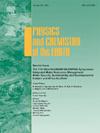提高产沙量估算精度:径流和植被动态的协同效应
IF 3
3区 地球科学
Q2 GEOSCIENCES, MULTIDISCIPLINARY
引用次数: 0
摘要
严重的洪水和大量的产沙给流域造成了许多问题。还需要进行更多的深入研究,以揭示河流现象中存在的模糊性。因此,完善和更新MUSLE等产沙估算模型的参数和因子对于提供更精确的结果,从而实现更有效的流域管理至关重要。为了实现这一目标,利用伊朗西北部Galazchai流域记录的38个降雨径流事件,优化了更多动态因素(包括径流和植被覆盖)在产沙量估算中的作用。因此,对径流的作用(即MUSLE模型的参数“m”)进行优化,并使用线性、对数、幂、逆和多元逆回归模型进行后续建模。此外,评估了5种基于植被覆盖度的c因子计算方法。结果表明,基于径流量和峰值流量的多元逆回归方法可以成功地估计出参数m。c因子也根据原始MUSLE模型中概述的方法1使用NDVI计算。修正后的MUSLE模型在定标和验证阶段的决定系数(R2)分别为0.87和0.56,可为Galazchai流域提供最佳的产沙估算。如果目前的调整方法在其他流域证明是有效的,它可以使参数“m”的准确和基于风暴的估计和精确的产沙量预测仅使用径流量和峰值流量数据。因此,本研究结果对加强侵蚀和沉积研究以及优化流域管理方案具有重要价值。本文章由计算机程序翻译,如有差异,请以英文原文为准。

Enhancing precision in sediment yield Estimation: The synergistic effects of runoff and vegetation dynamics
Severe floods and high sediment production have caused numerous problems in watersheds. More insight studies are yet to be conducted to disclose existing ambiguities in fluvial phenomena. Therefore, refining and updating the parameters and factors of sediment yield estimation models, such as MUSLE, is essential for providing more precise results, leading to more effective watershed management. To achieve this, the role of more dynamic factors, including runoff and vegetation cover, was optimized in sediment yield estimation using 38 rainfall-runoff events recorded in the Galazchai Watershed, Northwestern Iran. Accordingly, the role of runoff, the parameter “m” of the MUSLE model, was optimized, and subsequent modeling was performed using linear, logarithmic, power, inverse, and multivariate inverse regression models. Furthermore, five vegetation cover-based methods were assessed for calculating the C-factor. The results indicated that the parameter “m” was successfully estimated using multivariate inverse regression based on runoff volume and peak discharge. The C-factor was also calculated using NDVI according to Method 1 as outlined in the original MUSLE model. The adapted MUSLE model provided the best sediment yield estimate for the Galazchai Watershed with determination coefficients (R2) of 0.87 and 0.56 for the calibration and validation stages, respectively. If the present adapted approach proves effective in other watersheds, it could enable the accurate and storm-based estimation of parameter “m” and precise sediment yield predictions using only runoff volume and peak discharge data. Therefore, the findings from the current study are highly valuable for enhancing erosion and sedimentation research and optimizing watershed management programs.
求助全文
通过发布文献求助,成功后即可免费获取论文全文。
去求助
来源期刊

Physics and Chemistry of the Earth
地学-地球科学综合
CiteScore
5.40
自引率
2.70%
发文量
176
审稿时长
31.6 weeks
期刊介绍:
Physics and Chemistry of the Earth is an international interdisciplinary journal for the rapid publication of collections of refereed communications in separate thematic issues, either stemming from scientific meetings, or, especially compiled for the occasion. There is no restriction on the length of articles published in the journal. Physics and Chemistry of the Earth incorporates the separate Parts A, B and C which existed until the end of 2001.
Please note: the Editors are unable to consider submissions that are not invited or linked to a thematic issue. Please do not submit unsolicited papers.
The journal covers the following subject areas:
-Solid Earth and Geodesy:
(geology, geochemistry, tectonophysics, seismology, volcanology, palaeomagnetism and rock magnetism, electromagnetism and potential fields, marine and environmental geosciences as well as geodesy).
-Hydrology, Oceans and Atmosphere:
(hydrology and water resources research, engineering and management, oceanography and oceanic chemistry, shelf, sea, lake and river sciences, meteorology and atmospheric sciences incl. chemistry as well as climatology and glaciology).
-Solar-Terrestrial and Planetary Science:
(solar, heliospheric and solar-planetary sciences, geology, geophysics and atmospheric sciences of planets, satellites and small bodies as well as cosmochemistry and exobiology).
 求助内容:
求助内容: 应助结果提醒方式:
应助结果提醒方式:


